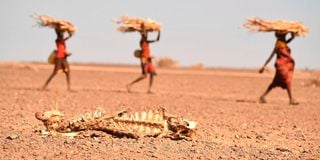Premium
Women, children most affected by drought in Laikipia, NDMA says

Women carrying firewood walk past a carcass of a cow in Loiyangalan in Marsabit, northern Kenya, on July 12, 2022.
The persistent dry spell has left thousands of residents of Laikipia County at risk of starvation, with women, children and the elderly the most affected.
An estimated 183,000 people are affected by the drought and are at risk of starvation, said the National Drought Management Authority (NDMA).
Laikipia North constituency and parts of Laikipia East are the most affected areas, said county NDMA coordinator Golicha Guyo.
In Laikipia North an acute water shortage has been reported. Several rivers have dried up and residents must walk long distances in search of water.
Herders are fleeing the area with their livestock in search of water and pasture in other parts of the country.
“Due to the drought situation, at least 7,000 herders from the affected parts of the county have moved to the Mt Kenya forest in search of water and pasture for their livestock where herders from Meru and Isiolo have also moved,” said Mr Guyo.
An assessment of who is affected was carried out last month, he said.
“Jointly with the Kenya Red Cross Society, the government has been addressing the crisis through distribution of relief food, and offering cash stipends, as well as undertaking offtake programmes,” he said.
“Between July and September, the Kenya Red Cross has assisted 1,500 households in Laikipia North with maize, beans, rice, cooking oil, green grams, and salt.”
The government, in partnership with the United Nations and other non-state actors, would scale up interventions in targeted critical areas, he added.
The NDMA had last week announced that the drought in Laikipia, Tharaka Nithi and Tana River counties had moved from alert stage to the alarm phase.
The three counties joined Isiolo, Mandera, Garissa, Turkana, Wajir, Samburu and Marsabit, bringing the number of counties in the alarm phase to 10.
The drought is attributed to failed rain seasons for a long time, with the number of those in dire need of relief aid projected to increase countrywide to 4.35 million by October.
Mr Joseph Kimiri, a resident of Sossian ward, told the Nation that some families were going for up to a day without a meal.
"The situation is worsening by the day, with desperate families forced to trek long distances in search of food, water and pasture for their livestock,” he said.
The NDMA had called for immediate interventions to curb malnutrition among children below six years old and lactating mothers in arid and semi-arid areas.
The agency said malnutrition among children and nursing mothers rose from 884,464 and 117,725 to 942,000 and 134,000, respectively, in August.





